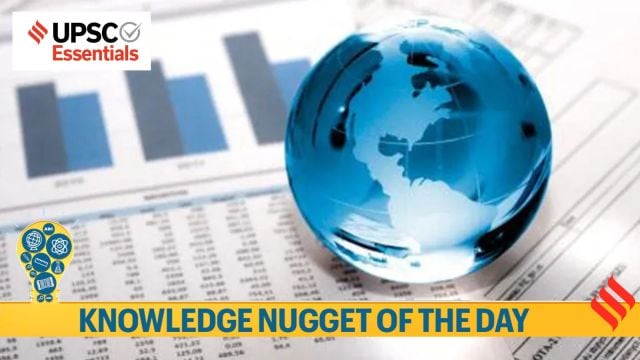
Key Takeaways :
1. An economy growing at relatively high rates would normally also attract capital flows from overseas investors keen to share in the benefits of that growth.
2. But the data shows net capital flows into India – that includes foreign investment, commercial borrowings, external assistance and non-resident Indian deposits – at just $18.3 billion in 2024-25, the lowest since the $7.8 billion in the global financial crisis year of 2008-09 and well below the all-time-high of $107.9 billion in 2007-08.
3. The trend has continued in the current fiscal, with capital inflows during April-June 2025 falling over 40% compared to that for April-June 2024. This was despite a stronger-than-expected GDP growth of 7.8% in the latest quarter.
4. A plausible explanation for India not receiving foreign capital flows commensurate with its status as the world’s fastest-growing major economy has to do with past investments.
5. A lot of FDI that flowed into India from roughly the middle of the last decade, peaking in 2020-21, were in the form of private equity (PE) and venture capital (VC) investments – in diverse sectors, from retail, e-commerce and financial services to green energy, healthcare and real estate.
Story continues below this ad
6. Those who put in this money are now cashing out by selling the shares they had originally bought, either to other firms engaged in the same business or via initial public offerings by the investee companies.
7. Something similar has happened with FPIs. Even as they have been on sell-off mode, their place has been taken by the more bullish domestic investors who have ensured attractive public market valuations for profitable exits – whether by FPIs or PE/VC firms.
8. India’s imports of goods far exceed its exports, resulting in large merchandise trade deficits that have more than trebled since 2007-08 to $287.2 billion in 2024-25. But the ballooning goods trade deficits have been greatly counterbalanced by surpluses on the “invisibles” account of the balance of payments (BOP), mainly arising from exports of services and private remittances sent by overseas Indians.
9. The invisibles surpluses have kept the overall current account deficits in India’s external transactions well below $50 billion in most years, as can be seen from the table. These deficits have then been comfortably financed through capital inflows, with excesses adding to the official foreign exchange reserves.
Story continues below this ad
10. That comfort could come under challenge, though, in a scenario of further widening of trade deficits or drying up of capital flows. The US President Donald Trump’s 50% tariffs on Indian goods can particularly derail shipments to a market that accounted for $86.5 billion out of its total goods exports of $437.7 billion in 2024-25.
11. . As far as capital inflows go, much rests upon how foreign investors perceive India. Their primary concern, beyond headline GDP growth numbers, is corporate earnings – whether these are rising sufficiently to justify their investments. For them, the overall business climate and sustainability of earnings is what matters; if market valuations are seen to be unreasonably high, they would rather cash out rather than invest afresh.
Foreign Portfolio Investment (FPI)
1. Foreign portfolio investment (FPI) is one of the common ways to invest in overseas economies. It includes securities and financial assets held by investors in another country. It also includes bonds or other debt issued by these companies or foreign governments, mutual funds, or exchange-traded funds (ETFs) that invest in assets abroad or overseas.
2. FPI is part of a country’s capital account. It is important to note that it is shown on its balance of payments (BOP). The BOP measures the amount of money flowing from one country to another country over one monetary year.
Story continues below this ad
3. The investor does not actively manage the investments through FPIs, he does not have control over the securities or the business. The investor’s goal is to create a quick return on his money. The FPI is often referred to as “hot money” because of its tendency to flee at the first signs of trouble in an economy. The FPI is relatively liquid depending on market volatility.
BEYOND THE NUGGET: Foreign Direct Investment
1. Foreign Direct Investment (FDI) is defined as an investment in which a company takes controlling ownership of a business entity in another country. Therefore, foreign companies get directly involved with day-to-day operations in other countries.
2. It is generally made in open economies that have a skilled workforce and growth prospects. This is significant as they are bringing money, knowledge, skills and technology along with them.
3. India gets FDI through two routes:
(i) Automatic route: Under this route, the non-resident or Indian company does not require a prior nod from the Reserve Bank of India (RBI) or the government of India for FDI.
Story continues below this ad
(ii) Government route: Under this route, the government’s approval is mandatory. The company will have to apply through Foreign Investment Facilitation Portal, which facilitates single-window clearance. The Department for Promotion of Industry and Internal Trade (DPIIT), Ministry of Commerce, issues the Standard Operating Procedure (SOP) for the processing of applications under the existing FDI policy.
Post Read Question
Consider the following: (UPSC CSE 2021)
1. Foreign currency convertible bonds
2. Foreign institutional investment with certain conditions
3. Global depository receipts
4. Non-resident external deposits
Which of the above can be included in Foreign Direct Investments?
(a) 1, 2 and 3
(b) 3 only
(c) 2 and 4
(d) 1 and 4
(Sources: Why foreign investors are not bullish on India, UPSC Essentials: Key terms of the past week)
Subscribe to our UPSC newsletter. Stay updated with the latest UPSC articles by joining our Telegram channel – Indian Express UPSC Hub, and follow us on Instagram and X.
Story continues below this ad
🚨 Click Here to read the UPSC Essentials magazine for August 2025. Share your views and suggestions in the comment box or at manas.srivastava@indianexpress.com🚨


































